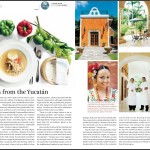 Fresh from the Yucatán Download PDF
Fresh from the Yucatán Download PDF
A mainstay of home cooking throughout Mexico’s Yucatán Peninsula and a standard on nearly every restaurant menu in the region, sopa de lima combines zesty Old and New World flavors. The basic elements are savory chicken broth, fiery habanero chili, and a tart blast from the lima fruit. According to Chef José Vázquez, a native of the Yucatán, the soup is a quintessential example of cultural fusion—centuries before the term was coined to describe a culinary movement.
The Yucatán is wedged between the Gulf of Mexico and the Caribbean Sea, geographically isolated from the country’s interior. “Historically, it has had a much closer relationship with Europe than has the rest of Mexico,” notes Vázquez, who studied at the California Culinary Institute and returned home to become head chef at Hacienda Xcanatún in Mérida, the Yucatán state capital. And sopa de lima, more than any other staple of local cuisine, represents the collision of indigenous Mayan foods with European, Asian, and Middle Eastern fare.
Pinpointing sopa de lima’s precise origins is hard, says Alejandra García Quintanilla, a history professor at the Universidad Autónoma de Yucatán in Mérida. “It was most likely derived from an ancient Mayan dish,” she explains. The Mayan diet relied heavily on maize, squash, beans, and chili peppers. “But the Mesoamerican peoples are extremely creative and sophisticated in the kitchen,” Quintanilla adds, “always trying new ingredients.”
One of those ingredients—the soup’s signature flavor—is the lima, a fragrant citrus fruit that arrived in the Yucatán with the Spanish in the 16th century. Its taste lands somewhere between a tangy Meyer lemon and a sweet key lime. Yucatecan chefs roast the lima whole on a hot comal, a heavy cast-iron skillet, before extracting its juice. Chickens also came with the Spanish conquistadors, although Quintanilla suspects that the Maya probably first prepared the dish using broth made from native wild turkey. For their part, the Maya contributed habanero chilies and corn tortillas.
“There is a rule in Maya culture to eat as naturally as possible,” says Vázquez. A simple dish with bold flavors, sopa de lima demands fresh ingredients. Vázquez uses ripe, aromatic limas (firm but not leathery) grown at the hotel’s hacienda.
Limas can also be found at the Chedraui and Soriana supermarkets in Mérida. “These cater to people in the lower middle class who make Yucatecan dishes, so you are sure to have lots of local produce,” Vázquez says. Or, he suggests, try the large Lucas de Gálvez market on Calle 56, south of the central Plaza Grande, or one of the neighborhood markets in such barrios as Santiago, Santa Ana (just west and north of the Plaza, respectively), and San Sebastián (Calle 70, southwest of the Plaza). “Mestizas come in from the countryside every day to sell their produce in these markets,” Vázquez says.
Sopa de lima varies among family recipes and regional adaptations. It’s sometimes seasoned with Yucatecan oregano (to impart a refined yet earthy flavor) or chile dulce, a cousin to the common green pepper, only smaller and subtler in flavor. In Mérida, sample Vázquez’s interpretation of the dish at the restaurant Casa de Piedra in the Hacienda Xcanatún (Calle 20 S/N, Comisaría Xcanatún, Km. 12 Carretera Mérida Progreso, 52/999-930-2140). Daniel Hoyer, who authored the cookbook
Mayan Cuisine, suggests Eladio’s (Calle 59, No. 425 x 44, 52/999-923-1087), a cantina that specializes in regional tapas. And at La Tradición (Calle 60, No. 293 x 25, 52/999-925-2526), chef David Cetina prepares sopa de lima from a time tested recipe passed down from his grandfather, who ran La Botana restaurant in Mérida more than 50 years ago.
Copyright © Michael Behar. All Rights Reserved.
